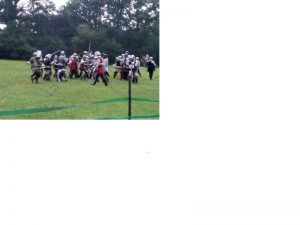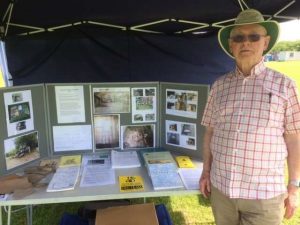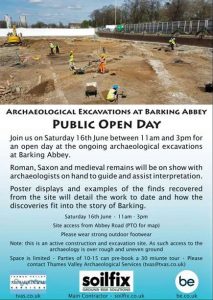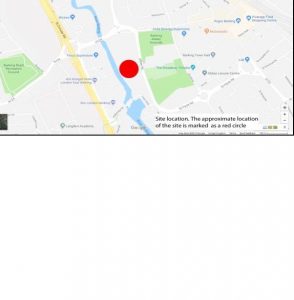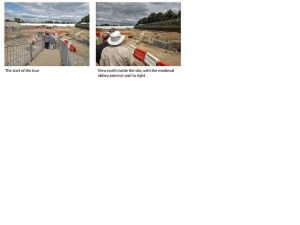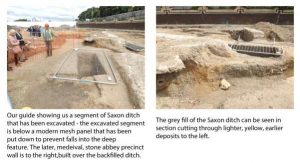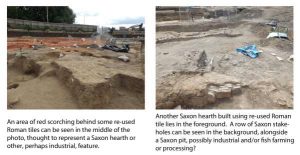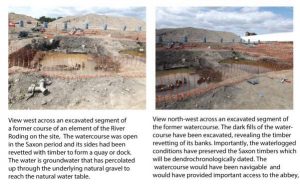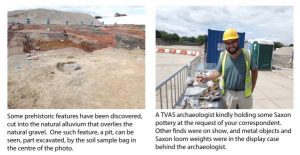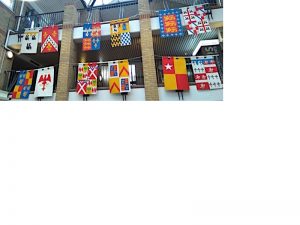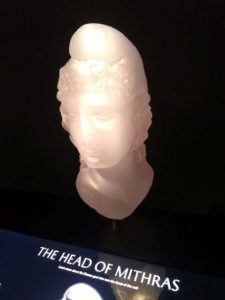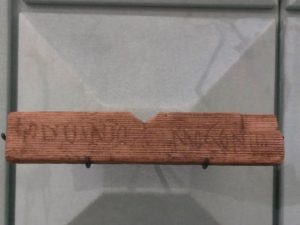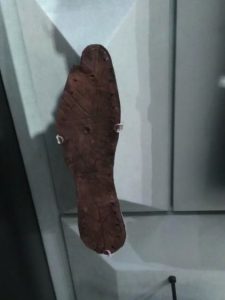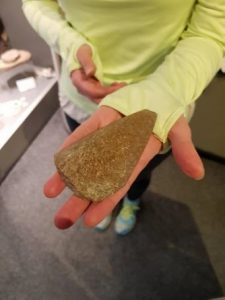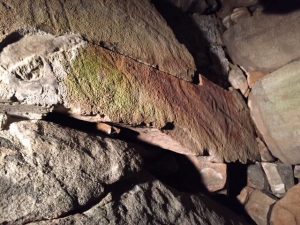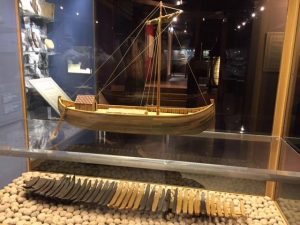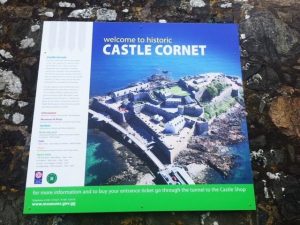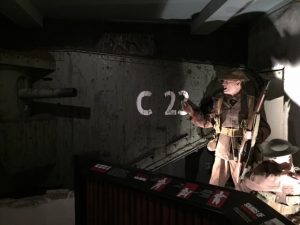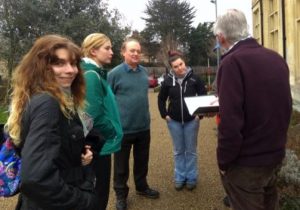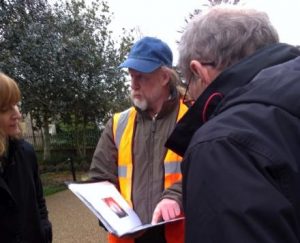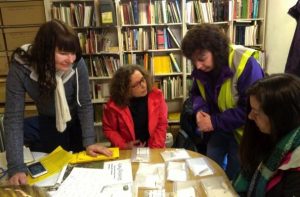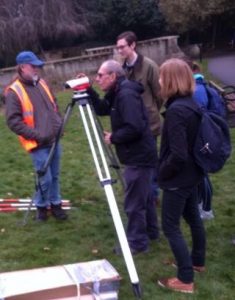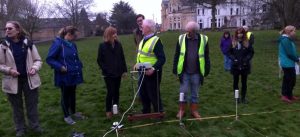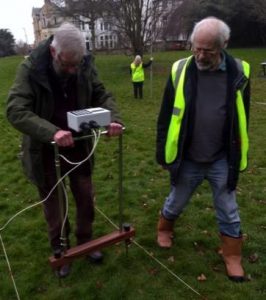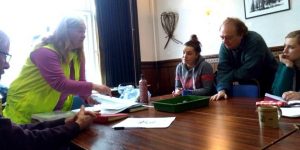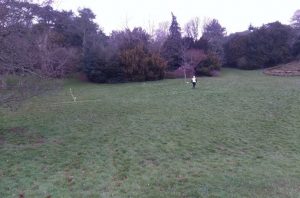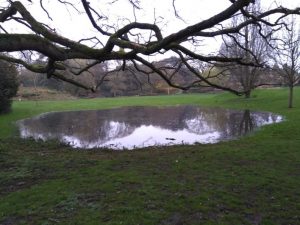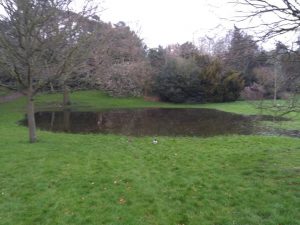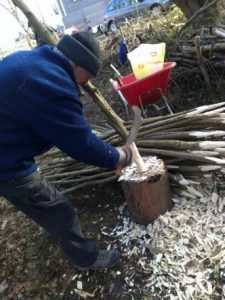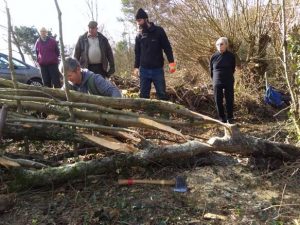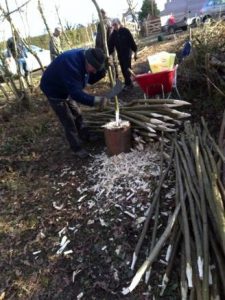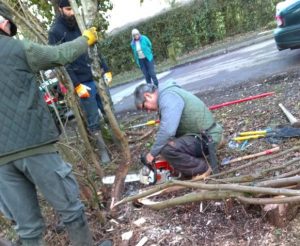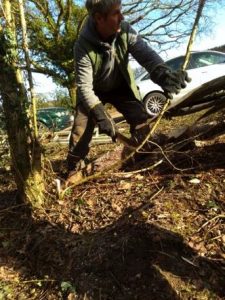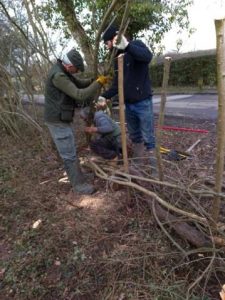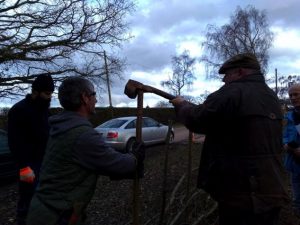|
HADAS Diary
Saturday 24 June OUTING TO NORTH OXFORDSHIRE with Micky Cohen and Micky Watkins. Details and application form enclosed with this Newsletter.
10 – – 14 July ORKNEY WEEK.
Details are now finalised. We are fully booked with a short waiting list but your name still can be added should you be interested. Please contact Dorothy Newbury as soon as possible.
Saturday 22 July OUTING TO DOVER with Tessa Smith and Sheila Woodwood. Details and application form with July Newsletter.
29-30 July HADAS ANNUAL ARCHAEOLOGY WEEKEND Experimental archaeology at College Farm! Further details are on page 4.
Saturday 19 August OUTING TO WALLINGFORD with Bill Bass. Details and application form will be in a later Newsletter.
The Ted Sammes evening
Our April meeting was dedicated to memories of HADAS founder member, the late Ted Sammes, who has left the Society a generous bequest. Long-standing member Sheila Woodward chaired the evening and spoke of her personal memories which she has reproduced for the Newsletter.
I joined HADAS in 1974 and must first have met Ted at outings and lectures during 1975. I soon came to appreciate his special qualities. For a start, there was the sheer breadth and depth of his archaeological knowledge. He seemed equally at home discussing a prehistoric chambered tomb or a Roman villa, Saxon pottery and pins or medieval floor tiles. He could speak authoritatively about different types of building bricks, about coinage and trading tokens, about delftware, about wig-curlers. The list seems endless. Ted’s experience in the baking trade was grist to his archaeological mill, as were his wartime experiences in the forces and his many subsequent travels in this country and abroad. His father had been a professional photographer and Ted developed a similar skill.
Being a perfectionist himself, and by nature cautious, Ted was always inclined to play devil’s advocate. Someone once said to me that every organisation needs a Ted Sammes! Any attempt to rush precipitously into a new project would be restrained by Ted’s “Have you checked on…?” “Are you sure that…?” or “Have you considered whether…?” This inclination to check over- enthusiasm and urge caution could give an impression of crotchitiness and ill-humour. In fact, Ted was immensely kind-hearted and always ready to share his archaeological knowledge and expertise. I often had cause to be grateful for his help and encouragement.
As a founder member of HADAS, Ted acknowledged his debt to the Society which fostered and helped him to develop his love of and interest in archaeology. That Society, in its turn, now acknowledges its debt to Ted Sammes and remembers him with great respect and affection
Matt Wheeler, the Curator of the Decorum Heritage Trust in Berkhamsted, provided a delightful insight into the Sammes family background.
I first came across Ted Sammes in 1997 when he phoned me up and told me that his father, Edward Sammes was a photographer and cabinet maker who had once lived in the village of Bovingdon and then later Boxmoor which are both near Hemel Hempstead. He wanted to know whether the Decorum Heritage Trust would like to provide a permanent home for his father’s collection of postcards, photographs and tools etc. Ted knew of the Trust because he had previously loaned some of the postcards to our current Chairman, Roger Hands and his wife Joan for use in their “Book of Boxmoor”. Ted Sammes evening (continued)
I expressed great interest and visited Ted at his home in Taplow. I learned a great deal about his father’s life and at the same time collected the extensive collection of postcards, photographs and other ephemera. At a later date I hired a van and went with Ted and one of our volunteers to his father’s old flat in Hendon in order to collect a large tool chest and his father’s workbench. Unfortunately, we picked the hottest day that summer to do the move. Things were not helped by the fact that Ted was already quite frail at the time and so we had to literally hoist him in and out of the transit. So there we were in the 90° heat struggling with this large, cumbersome tool chest and workbench on the second floor of a block of flats in North London which had no lift!
Now housed at the Trust’s Museum Store in Berkhamsted, the tool chest in particular is an absolute gem containing tools that have been lovingly cared for as well as examples of Edward’s carving. There’s even a little motto on the inside of the lid which was placed there by his mother. It reads:
Sloth like rust consumes
Faster then labour wins
While the used key is always bright
God helps them that helps themselves.
Lost time is never found again.
Edward Sammes was born in Chipping Ongar in Essex in 1883, the son of John (“Jack”) and Alice Sammes. The family moved to the village Bovingdon in 1887 in order to run the Wheatsheaf beerhouse (still there today). As with many Victorian couples, Jack and Alice produced quite a few children two daughters Emma and Alice and five sons including John who helped his father run the beerhouse and Edward.
In the collection we have a pewter mug which was apparently used at The Wheatsheaf. It serves no practical purpose now because it has a big hole in it which was caused by an incendiary bomb that hit the family’s house in Hendon during the Second World War.
We also have an account book which shows the pub’s
weekly takings for the period 1887-1892 – ie the time
when Jack Sammes was there. The takings tend to be the highest during the months of August and September and this was probably because those were the harvest months when agricultural labourers had a few more pennies in their pocket. The highest weekly takings shown in the book were during the week of 30 August 1891 when they took £10 l0s 5 1/2d. The book also shows the accounts for Jack’s side-line business of painting and decorating.
There are many items in the collection which relate to the family’s time in Bovingdon. including an invitation card for the village celebration of Queen Victoria’s Diamond Jubilee and a photograph of Edward and other pupils of Bovingdon School in 1890.
When Edward reached the age of 16 (in 1899) he became apprenticed to Robert Smith of Hemel Hempstead at a cost of £20 for training as a cabinet maker. He obtained his indentures five years later. In 1903, Edward’s father died suddenly at the age of 58 and the family moved to Oxford Villa in St John’s Road, Boxmoor. Edward continued working for Mr Smith until 1906 but soon afterwards set up on his own with a workshop on the corner of Kingsland Road and Wharf Road. He set up a business as a cabinet maker, furniture restorer and commercial photographer.
For his photography, he had no special premises nor studio but used the box room over the front door for day work and the scullery for developing and printing after the family had gone to bed. Most of the postcards in the collection date from the period 1905-1914 so you could say that the golden period of photography as far as Edward was concerned was in fact the Edwardian period. This was true throughout the whole country – the period 1900 to 1914 was the golden period for postcards as they were the most widely used form of communication before telephones became the norm. Edward’s postcards were of the standard size, the size used by most photographers since 1899 and each one would have been individually printed hence their rarity.
Edward used a “Junior Sanderson” quarter plate camera manufactured by Houghton’s throughout his career. He was commissioned by people to take pictures of their loved ones. Many of these portraits were never intended to be posted and so they don’t have post marks on them. His camera captured every period of a person’s life from birth to death. Edward also photographed people’s houses, pets, cars, businesses, local clinics and hospital parades.
When the First World War began in 1914, Edward moved to Hendon as he worked as a supervisor at the Aircraft Manufacturing Company at Colindale in the section producing wooden components of aircraft. During this period his main contact with Boxmoor was his visits whilst courting Dorothy Ella Sharp (known as Ella) who was originally from Berkhamsted but later lived in the Dell on Roughdown Common. They were married in 1917 at St John’s Church. They then lived for a couple years in Hendon and in 1920 their only child, Ted was born. They moved back to Boxmoor shortly afterwards together with their baby son.
Edward was also very interested and involved in local politics and in particular with the Hemel Hempstead Labour Party. During the period of 1905 to 1931 he was at various times the Honorary Secretary, the Chairman and Vice-President of the Hemel Hempstead Labour Party. He was also an agent during the elections of 1922, 1924, 1929 and 1931. He even helped to establish the Hemel Hempstead Co-operative Society in 1906 and served on its management and educational committees.
When the family came back to Boxmoor they moved to 129 Horsecroft Road which they rented from James Loosley, a retired butcher of St John’s Road at a cost of just under £4 a month. In theory, this looked to be an ideal move because the house also had a workshop at the back. However, things quickly turned sour as life for the Sammes family was becoming a hard struggle to make ends meet. After the First World War, postcards had lost their popular appeal. People began to use the telephone and postcards became more expensive for the photographer to produce – the cost of paper increased and there was an increase in the postage rate from halfpenny to a penny. In such a climate, the Sammes family soon fell behind with the rent and by September 1927 things had got so desperate that the family arranged for Walter Greey the auctioneer of Hemel Hempstead to hold an auction and sell off all their possessions. We are lucky enough to have a copy of the poster in the collection. Basically, they were planning to sell everything they owned – pillows, beds, Windsor chairs, books, tools, the work bench, chest of drawers. Fortunately, at the eleventh hour, a kindly friend loaned the family enough to pay off their debts and the sale was ‘cancelled.
In 1928, Mr Loosely took proceedings against Edward Sammes at the County Court in St Albans for owing him £31 in rent and not vacating the premises. Edward was taken to court again in February of that year and by March, he removed some of his possessions out of the premises and the family moved temporarily to an address near Boxmoor Station. It was during this move that all his negatives were lost. Not long after in December the family moved to Hendon.
It was in Hendon that Edward and his wife spent the rest of their life. His interest in politics continued as he was a founder member of the Hendon South Labour Party and acted as an agent for its first candidate. He still remained active in the local co-operative movement and was also one time editor of the “Hendon Citizen”. He died in April 1969 at the age of 85. During his relatively short period of commercial photography he achieved a legacy of over 200 photographs of this area. We are very lucky that Ted Sammes kept his father’s collection intact as it provides quite literally, a “snapshot” of what life was like in Edwardian Dacorum. The Dacorum Heritage Trust, in particular, is fortunate that Ted donated this wonderful collection with us before he died and for that reason the names of Edward and Ted Sammes will continue to be remembered with great fondness by people in Dacorum.
Joan Hands, wife of the Chair of the Dacorum Museum Trust, attended the evening and presented a copy of the “Book of Boxmoor” to HADAS on behalf of her husband Roger as Ted had contributed a chapter to the book.
Gerrard Roots, Curator of Church Farmhouse Museum, Hendon has now prepared some 120 exhibitions at the Museum, the first being HADAS’s, Pinning Down the Past. This was planned by Brigid Grafton Green and Ted Sammes. He and Ted did not always see eye to eye and there were some “lively” exchanges of views. One Man’s Archaeology was another of Ted’s successful displays. In the 1980s Ted wanted to do an exhibition on the history of the Labour Party, a cause close to his heart, but they didn’t do it much to Gerrard’s regret. Ted always arrived at the Museum with lots of bags but would never reveal what was in them. Discussing his excursions over the years to Spain, Malta and Turkey, Ted revealed “1 think that without HADAS I would not have visited these places”. Gerrard recalled how Ted, having battled with one committee or another and arriving at an impasse, saying “What can one man do?” Well, according to Gerrard, he did an astonishing amount!
Brian Boulter of Maidenhead spoke of Ted as a friend and colleague; they met when Brian joined Weston Research in Dagenham in 1954. Ted began work as a lab boy with H W Neville’s at Acton, and his father went with him to the interview. When they said how much money he would receive, with a review at the end of a year, his father said he wanted it in writing. Soon after, when the firm would have liked to pay him more, they couldn’t because the pay rate was in writing! His job was testing flour and he worked at Walthamstow and King’s Cross, possibly attending Acton Tech. At the outbreak of war Ted joined the Army and volunteered for a hush-hush project as a radar mechanic because of his scientific experience, albeit food technology – but where he was posted there was no radar! Re-trained in radio, he went to Naples when Vesuvius erupted.
After the war, Ted’s firm was bought out and they moved first to Dagenham, then to new labs in Chessington a couple of years later, then finally to Taplow where, after years of commuting, Ted came to live. His job latterly involved visiting watermills and windmills, an interest which spilled into his private life. giving an inspiring talk on mills to HADAS following the AGM in May 1995.
Brian got to know Ted gradually and, learning of his interest in local history, introduced him to the Maidenhead Archaeological Society. He also became involved in the Maidenhead Civic Society who set up a Museum which Ted had lobbied for which despite a lease on premises for only six months was very successful.
Pam Taylor, ex Borough Archivist and HADAS member, knew Ted from the 1980s when he visited the Borough Archive. She explained that he had a great sense of where things fitted in. He also had a “chip on his shoulder’ and put on an irascible front. HADAS wanted at that time to produce an archaeological history up to 1500. Everyone queued up to do the prehistoric and Roman, not the medieval, so Ted and Pam set to work on the medieval section but experienced a conflict between archaeology and history. The resulting publication is of course, the HADAS standard A Place in Time. However, Ted and Pam emerged from this collaboration as friends. He didn’t bear grudges – although he was bitter towards organisations and how they just didn’t work. In Ted’s last month’s Pam only saw him a couple of times, and recalled visiting his home to collect some items and records for the Archive. She was impressed by the organisation of his attic – the place where the majority of us throw things into heaps. There was a library of items carefully sorted and, although he was not fit enough to ascend the steps, he was carefully explaining the correct angle of drop for the boxes coming out of the loft. We could understand how Pam’s one regret was not having had time for more visits.
HADAS Chairman, Andrew Selkirk, first knew of Ted because of the Prehistoric Society book Discovering South East England. Ted directed excavations at Church End in 1973/74 and the exhibition Pinning Down the Past. Andrew went down to Maidenhead, and wrote a four-page account of the excavation because Ted published the objects rather than the excavation itself.
In 1994 Ted was elected a Fellow of the Society of Antiquaries; a worthy body formed in 1717 Acceptance of a nomination is decided by the black ball system, the nearest thing these days to a public hanging. If you get six white balls you are okay, but when Ralph Merrifield put Ted’s name up there were no black balls whatsoever.
At the end of the evening there was time to look at the displays put together by Sheila Woodward, Dorothy Newbury and Tessa Smith, to raise a glass and chat a while. But when Ted’s portrait, which had overlooked the evening’s affairs, slipped onto its face – we understood he had had enough and it was time to go home. Dorothy Newbury has asked for the Society’s thanks to go to all who helped prepare beforehand and on the night.
Members’ News
Congratulations to Danny and Helen Lampert who celebrated their 60th wedding anniversary last month. They joined HADAS in its very early years and have been active members ever since.
Following hard on their heels are Arthur and Vera Till who recently celebrated their 50th wedding anniversary. Those who have excavated with Arthur will not be surprised to learn his wedding day was on 1 April!
Mary O’Connell will be entering hospital in Bristol, near her daughter, for a hip replacement in June. We send our best wishes and look forward in due course to a resumption of one of the most popular events of the HADAS calendar, Mary’s annual London walk and visit.
At the time of writing, Dorothy Newbury is resting after a minor operation on her legs and no doubt will be on the fully-active list long before her doctor would wish.
Our lecture season starts again in November and at last our booking problems with Barnet Council have been resolved, writes Dorothy Newbury (Programme Secretary). The Drawing Room on the ground floor of Avenue House has been booked for the second Tuesday of each lecture month until 2003. Special thanks must be given to June Porges for organising our speakers, often providing refreshments for the long distance ones, and to Vikki O’Connor for relieving June from the job of “coffee lady”. We should also thank “the boys” for arranging the projector, screen, tables and the bookstall. The change to lecture start time of 8.00pm with coffee afterwards is working well but please remember we must vacate the room by 10.00pm promptly with all cups returned to the back table.
HADAS Annual Archaeology Weekend 29 – 30 July (revised date)
This weekend is dedicated to experimental pot-firing at College Farm, Fitzalan Road, Finchley. Volunteers are needed to advise and/or participate in this high-profile event especially those with experience in any aspects of clay- working, pot-making, decorating and kiln-firing. There will be other events on the weekend which will need supervising so please contact Bill Bass on 020 8449 5666 if you have some time to spare between now and the end of July or on the weekend itself.
The Bricks of Brockley Hill by Brian McCarthy
As reported in the February Newsletter, Peter Nicholson and I have been attending the Museum of London Specialist Services Laboratories at Eagle Wharf Road to learn how to identify the ceramic building material (CBM) that was collected from the Brockley Hill fieldwalk in the summer of 1998. The grant from English Heritage is to cover the cost of our instruction, the supervision of our earlier work and the eventual write-up of the results for publication.
To date we have spent five full days together at Eagle Wharf Road which we thought was all that had been paid for. However, it seems that because we came together each time, MoLAS, by some peculiar arithmetic, has worked out that we are entitled to another one and a half days. So far we have worked through virtually all the boxes of samples that Bill Bass transported to MoLAS for us and now we are ready to deal with the remainder.
Our instructor is Dr Ian Betts (who lives in the Borough of Barnet) and is the head of the CBM section. Under his watchful eye, we have been going through each bag for each 2 metre square, one piece at a time. We first look at the sample through the binocular microscope and identify the fabric type by comparison with those in the MoLAS type library, Every clay has a different chemical content and, after firing, has an individual physical appearance which can be seen in the microscope. In the main, most of our Roman samples consist of four different types – all similar – and it is assumed that they all originate from different clay pits in and around the Brockley Hill kilns. We now have a set of our own type samples so that work done locally will be assessed to agreed national types.
After identification by type, the samples are weighed, measured and special features noted and all recorded on a separate form for each 2m square. The final decision is whether to retain or throw away and the usual course is the latter, unless there is something different or unusual about it. So far we have seen Roman tegulae, imbrex and brick and, in addition, a considerable quantity of post-medieval peg tile, pantile and brick. These too are fabric typed, weighed, assessed, recorded and retained or thrown.
Much work remains to be done and we hope to do it at Avenue House or elsewhere, involving as many people as possible. However, we have found that recognition of type samples is a slow and laborious process so it is going to take quite a lot of time. If you are interesting in acquiring a new skill, we hope to organise some weekday or weekend sessions in the near future.
Finally, Ian Betts, who we cannot thank enough, has suggested that he comes to us for our next session to help sort out any problems and keep us on the right road. That will leave the last half day to be devoted to drawing it all together at the end.
We have found it to be a fascinating and illuminating experience with friendly and helpful people. Hopefully, we will be able to pass on our knowledge in an equally amiable way.
The “C” Team: Peter Nicholson has already set up his “B” team comprising himself and two others, and is working one or two afternoons a week at Avenue House. In turn, these two are just about ready to work on their own. However, we need to get a “C” team going as soon as possible. Peter and Brian will spend a few sessions instructing two new people to get this going. This could be arranged for a weekday or Saturday. Please contact Vikki O’Connor (020 8361 1350) if you are interested. We are keen to get the processing finished before this winter.
HADAS project at Barnet Gate, Arkley
Following our recent resistivity survey at the Meadow at Barnet Gate off Hendon Wood Lane, permission was obtained from the Countryside Officer of Barnet Council to undertake trial-trenching in the areas where anomalies were noted. Work will have commenced over the Bank Holiday weekend but we fully anticipate continuing with weekday and weekend working for a short time. If you are interested in participating in this project, please contact members of the team.
A return to Sunninges Grove Philip Bailey
The story of Sunninges continues, but first there is a correction to the item received from Brian Warren in the May Newsletter, page 3. The second line should have included the word “not” as follows.- “He (Philip Bailey) suggests that “Sunningas Grove” was not within “Enfield Chase”, but if . .” Philip is aware of this omission and his follow-up below allows for it,
As Brian Warren quite rightly pointed out in his article in the last Newsletter (349) Sunninges Grove did lay within the Manor of Barnet in the 16th and 17th centuries according to the boundary descriptions of the Enfield Chase. I was aware of this but felt that since I was looking at the history of the grove in the 13th century and earlier, I did not feel that this had much bearing on its position in relation to the boundary at that time, particularly since as Brian pointed out, it was so close to the boundary in the 17th century that it actually formed part of it.
My assumption that the grove was outside Barnet was admittedly a bit misleading but was based on the somewhat confusing 13th century references to the grove. In my article I was simply pointing out the existence of the grove, and have little understanding of medieval land transactions or for that matter Latin, in which some of the original references appear, so don’t claim fully to understand the situation in the 13th century. I assumed that by “acquired’ it was meant “purchased” but since the grove was twice acquired by the Abbey in the 13th century I have come to the conclusion that it doesn’t. I therefore had assumed that when the reference in Cass says that the grove was acquired by the Abbey from the widow of Henry Frowick that this was the point at which the grove was included within the Manor of Barnet.
Since Sunninges Grove seems (at least to me) to have had a confusing early history I list below all the references to it that I am aware of. There does however seem little doubt that both Henry de Frowick of Old Fold and also the Priory Hospital of St John Jerusalem (in Clerkenwell) both held the grove at different times. If it seems strange that Henry Frowick held the grove when his land was some distance away north of Barnet, it must be equally strange that it was also held by the Priory of St John who locally held Friern Barnet to the west of Barnet when Sunninges Grove was on Barnet’s eastern boundary.
On the point of Moneland, I suspect that Brian is right in thinking that it was next to Old Fold. There are several references in the manor rolls to land within Barnet Manor laying next to Old Fold, although they are more specifically positioned there, and I list those also below.
References to Sunninges, Moneland and Old Fold
c 1260-90 Item, adquisivit de Ysabella, relicta Henrici de Frowik, quandamlquendam gravam in Est Barnet quae
voatur “Sunninges grave”. (Also, acquired from Isabella, widow of Henry de Frowick a certain grove in East Barnet, that is called “Sunninges Grove.”) Gesta Abbatum EB by Cass pg 13, SM by Cass, pg 71.
1280 Richard Doget conceded and quit-claimed to the Lord Abbot 2d of annual rent which Henry de Frowick was
wont to pay him for a certain ditch of that grove which the Abbot has of the great hospital. (Cat Hill in East Barnet was formerly known as Doggetts Hill) Manor Rolls, translated version in Barnet Museum.
1260-90 Item, perquisivit de Fratre Joseph de Chauncy, Priore Hospitalis Jerusalem in Anglia, unam gravam quae
fuit Henrici Frowik in Barnet. (Also, acquired from Brother Joseph de Chauncy, Prior of the Jerusalem Hospital in England, a grove that was Henry of Frowick’s in Barnet. Gesta Abbatum SM by Cass, pg 71.
1272 “Moneland” 2 acres and a house next to the land of Henry de Frowick. Barnet Rolls, translated version. Regarding Old Fold, from Barnet Rolls:
1262 …1 acre of land next to the Old Fold
1272 …Robert Smalhak renders an acre of land next to the “Old Fold”
1291 …Rosa Geoffreys surrendered an acre of land which lies next to “le elde folde”
1291 …Richard le Rede surrendered a messuage [house] lying up to Oulde Folde. (Richard le Rede appears in the Rolls in 1290.)
1292 …an acre of land under Olde Foulde
1347 Et una acre terra jacet sub le Elde Folde, inter terram quondam Agretis le Rok et terram quondam Ricardi Spryngold, et quam acram idem Ricardis quondam tenuit ad voluntatem domini per virgarn. (And one acre of land lying under “Le Elde Folde” between land formerly Agretis le Rok and land formerly Richard Springold …etc.
Also perhaps relevant to Old Fold:
1317 John de la Penne Barnet Subsidy Rolls, Cass, pg 15.
1344 William atte Penne (de La Barnet.) Forged deeds of lands at Barnet and a messuage at South Mimms. This led to a trial by assize at St Albans. Gesta Abbatum SM by Cass, pg 18,19.
Avenue House Consultative Conference, 10th April 2000 by Andy Simpson
This was a follow-on conference to that held last year and previously reported in Newsletter No. 342, September, 1999, which considered the future of the 10.2 acre Avenue House Estate, Finchley, both House and grounds (excluding Hertford Lodge) where HADAS rents the garden room as an office and library/archives store. The writer of this report again attended as HADAS representative. It was reassuring to see that Council bureaucracy maintains its traditional
standards – my formal invitation arrived the morning
after the conference.
The same user groups as last time were represented, including Friends of Avenue House and the Finchley Society. Research undertaken by the existing 9-member Avenue House Steering Group on the estates’ future management was set out in a proposals document, duly discussed at the meeting, which was chaired by Councillor Susette Palmer, Chair of the Steering Group, which was set up by the Council to develop the arrangements and report back.. The new Estate Manager, Anne Denison, appointed in January, was
present – a positive step, as promised by the Council at
the last meeting. She is presently working on a business plan for the estate, which it is hoped will be running independently through devolved management by June 2000 as a self-supporting limited company run by a management committee at arm’s length from Council control.
It is intended that the new body will have a constitution and officers, through whom it will act. This management body will include one Council member from each of the main political parties, ‘casual user’ and ‘leaseholder’ representatives, Barnet Voluntary Services Council, the Finchley Society, Friends of Avenue House Estate and Friends of Parks groups, and up to three co-opted specialist advisors such as Kew Gardens. The association would elect its own chairperson and have the power to appoint subcommittees to cover staffing, budget etc. Meetings would be in public, with the Council as Corporate Trustee informed of all decisions. A Council officer may act as Treasurer to carry out the managing group’s instructions if finance was available and they corresponded with the agreed operating plan. Council grants could be applied for and a twice-yearly public forum will be held to review and comment on the Annual Report, and once for consultation on the Operating Plan and Budget, prior to their submission to the Council. The committee must comply with all charity rules and would set all facility hire charges; the Council will be entitled to use rooms, on payment of a fair charge. After two years operation the position will be reviewed. As it will remain as Corporate Trustee, the Council will require to see and approve the annual operating plan, budget and accounts and Annual Report to the Charity Commission and reserves the right to intervene in the event of financial mismanagement or similar problems which could endanger the future of the estate. As stressed before, the estate needs to work within the bounds of the Stephens Trust and there is no endowment to meet initial running costs such as staff salaries. There may be a public appeal to raise back up funding. The issue of safeguarding staff pensions is under investigation as an admitted body under the Borough of Barnet Pension Fund. The Council expects any new managing body and the estate to operate without Council subsidy.
This was purely a consultative conference – the
elections to the management body of representatives of interested groups had yet to occur at the time of writing. The Council hoped to leave this largely to the groups concerned by suggesting they meet up and select their candidates. There was some discussion as to who should qualify; I had to remind the meeting that HADAS were both a resident group and one of some 40 casual user’ groups and organisations through their hire of rooms for lectures and other meetings, though not enough to qualify for the proposed ‘casual user’ qualification level of 10 meetings per year. I again had to point out that as leaseholding residents we were present in the Garden Room most Weekends even if not hiring a function room 10 times a year. The ‘qualifying level’ will hopefully be set lower in the end.
It was suggested that expert groups such as English Heritage (who did not take up the previous offer of a seat on the Steering Group), The National Trust or Kew Gardens might be co-opted to the committee for specialist advice. The Council had held talks with the Hertfordshire Building Development Trust as possible managers of the estate but this possibility was not proceeded with, but contact would be maintained in an advisory capacity.
A questionnaire on the Steering Group’s proposals was circulated; HADAS have completed and submitted theirs, generally agreeing with the proposals but insistent that the status and rights of established local user groups such as ourselves who provide services to the Borough and local residents must be protected, and not be lost to the interests of commercial organisations. Further developments are awaited.
Governing London: lessons from 1000 years by Ann Saunders
On 11 April, about seventy historians and other interested individuals gathered at the Museum of London to hear a series of lectures on the governance of the capital. The speakers were:
Dr Derek Keene (Centre for Metropolitan History) Roots and Branches of Power 1000-1300
Dr Caroline Barron (Royal Holloway) Shaping Civic Government 1300-1550
Dr Ian Archer (Keble College, Oxford) The City and the Challenge of Metropolitan Growth 1550-1650 Dr Vanessa Harding (Birkbeck College, Landon) Parishes and Powers in the Metropolis 1650-1750
Dr Roland Quinault (North London University) From National to World Metropolis: Governing London 1750-1850 Dr John Davis (Queen’s College, Oxford) New Challenges and New Authorities 1850-1920
Professor Ken Young (Queen Mary and Westfield College, London) Ideals and Reality 1920-1986
Dr Tony Travers (London School of Economics and Political Science) Abolition and Reconstruction 1986-2000
The standard of scholarship and lecturing was high; happily, all the texts are to be published in a future issue of The
London Journal. The discussion was spirited if – as one might expect – inconclusive. None of the mayoral candidates
was present, as far as your reporter could tell. Never mind. A good time was had by all, and before you read this, we shall have a mayor. Wonder what will happen next?
City of London Archaeological Society at the Tower of London
The COLAS National Archaeology Weekend (22-23 July from 9.00am till 4.30pm.at the Tower of London) will have many hands-on exhibits as well as foreshore collecting. COLAS would welcome assistance from HADAS members with finds identification skills who can help at this event. Please contact Vice Chair, Carol Bentley.
Other Societies Events Compiled by Eric Morgan
Amateur Geological Society Tuesday 13 June at 8.00pm.
Talk: The Pleasures & Pitfalls of Writing Geology for the General Public (Susanna Van Rose) The Parlour, St Margaret’s Church, Victoria Avenue, Finchley, N3. (£1.00 donation)
Barnet & District Local History Society Wednesday 14 June at 8.00pm.
Talk: Bandstands – Parks and Seaside (with music) (Paul Taylor)
Wesley Hall, Stapylton Road, Barnet.
Willesden Local History Society Wednesday 21 June at 8.00pm.
Annual General Meeting.
Willesden Gallery, Willesden Green Library, High Road, NW10. (£1.00 donation)
Hampstead Scientific Society Thursday 22 June at 8.15pm.
Annual General Meeting followed by Scientific Entertainment.
St John’s Church, Church Row, Hampstead, NW3 (Wine & Cheese £2.00)
Finchley Society Thursday 29 June at 8.00pm.
Members’ Evening including Barnet at War by Percy Reboul. Drawing Room, Avenue House, East End Road, Finchley, N3.
CBA Mid Anglia Summer Conference
Saturday 10 June, 10.00am – 4.30pm at the Plinston Hall, Broadway, Letchworth, Hertfordshire. Morning Session: The Treasure Act, 1996
Afternoon Session: The Voluntary Recording of Portable Antiquities
Tickets £10.00 available from Mr D Hills, 34 Kingfisher Close, Wheathampstead, Herts, AL4 8JJ.
Cheques payable to CBA Mid Anglia Region.
Exhibitions & Festivals
Manor Park Museum until 8 July.
Made at New Canton: the story of Bow Porcelain 1750-1776.
Romford Road, London, E12.
This exhibition commemorates the 250th anniversary of the factory which was situated on the banks of the River Lea near the Bow Flyover and Stratford High Street. The exhibition will be open from 10 00am to 5.00pm on Tuesdays, Fridays and Saturdays and from 1.00pm to 8.00pm on Thursdays.
Highgate Literary & Scientific Institution 3-15 June (See May Newsletter for times)
Highgate 2000: A Journey through Time.
Highgate Literary & Scientific Institution, 11 South Grove, London, N6.
Included in the exhibition are several Roman pots from the Highgate Wood kilns and flints from the same site on loan from the Museum of London. HADAS members might wish to compare these with the Brockley Hill and West Heath finds respectively.
Church Farmhouse Museum 3-18 June.
Twin Towns Exhibition with ceramics, art and photographs from Barnet’s twin towns in Israel, Germany and Cyprus.
East Finchley Community Festival Sunday 18 June.
At Cherry Tree Woods, opposite East Finchley Underground Station.
East Barnet Community Festival Saturday & Sunday 1-2 July.
At Oak Hill Park, N20. HADAS will have a display and book stall at this event.
Hampstead Garden Suburb Residents’ Association
The Hampstead Garden Suburb Festival 2000 will run during the month of July, with a special day planned for Saturday 8 July on and around Central Square. HADAS members from all over the Borough are welcome to help with the HADAS stand (contact Vikki O’Connor on 020 8361 1350) or just come along to browse.
|




